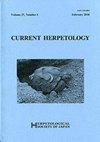墨西哥普埃布拉北卡罗来纳地区裂口异角龙的生态学研究
IF 0.7
4区 生物学
Q4 ZOOLOGY
引用次数: 4
摘要
摘要:异齿龙属蜥蜴是一种生活在缝隙中的蜥蜴。它们的缝隙居住习惯可能会限制它们的生态;因此,人们可以预测,物种之间的几种生态特征可能存在有限的变异。在这里,我们报道了最近描述的来自墨西哥普埃布拉东北山脉的分形Xenosaurus fractus的生态学方面,并将其与其他物种的Xenosaulus进行了比较。fractus的平均体温为19.67°C。体温与空气温度和基质温度有关。我们发现雄性和雌性在热生态方面没有差异。缝隙使用与个体的体型无关,男性和女性在缝隙使用方面也没有差异。Crevice特征对体温的影响有限。除了头部宽度与口鼻部长度的相对增长存在二型性外,在体型或头部大小上不存在性大小二型性。分形异龙主要以昆虫为食,毛虫是最重要的猎物。总之,X.fractus的生态学在许多方面与其他种类的Xenosaurus相似。特别令人感兴趣的是,观察到X.fractus与其姊妹物种X.tzacualtepantecus的相似性似乎并不比其他物种的Xenosaurus更高。本文章由计算机程序翻译,如有差异,请以英文原文为准。
Ecology of Xenosaurus fractus (Squamata: Xenosauridae) from Sierra Nororiental, Puebla, Mexico
Abstract: Lizards in the genus Xenosaurus are crevice-dwelling lizards. Their crevice-dwelling habit may constrain their ecology; thus one might predict there could be limited variation in several ecological traits among species. Here we report on aspects of the ecology of the recently described Xenosaurus fractus from the Sierra Nororiental of Puebla, Mexico and compare it to other species of Xenosaurus. Mean body temperature of X. fractus was 19.67°C. Body temperature was related to air temperature and substrate temperature. We found no difference in thermal ecology between males and females. Crevice use was not related to the individual's body size, nor did male and females differ in crevice use. Crevice characteristics had limited effects on body temperature. Sexual size dimorphism was not present in body size or head size, except for dimorphism in the relative growth of head width with snout-vent length. Xenosaurus fractus ate mostly insects, with caterpillars the most important prey. In conclusion, the ecology of X. fractus is similar to other species of Xenosaurus in many ways. Of particular interest is the observation that X. fractus does not appear to be any more similar to its sister species X. tzacualtepantecus than it is to other species of Xenosaurus.
求助全文
通过发布文献求助,成功后即可免费获取论文全文。
去求助
来源期刊

Current Herpetology
Agricultural and Biological Sciences-Animal Science and Zoology
CiteScore
1.20
自引率
14.30%
发文量
20
期刊介绍:
Current Herpetology publishes original research articles on amphibians and reptiles. It is the official journal of the Herpetological Society of Japan and is a continuation of Acta Herpetologica Japonica (1964–1971) and Japanese Journal of Herpetology (1972-1999).
 求助内容:
求助内容: 应助结果提醒方式:
应助结果提醒方式:


